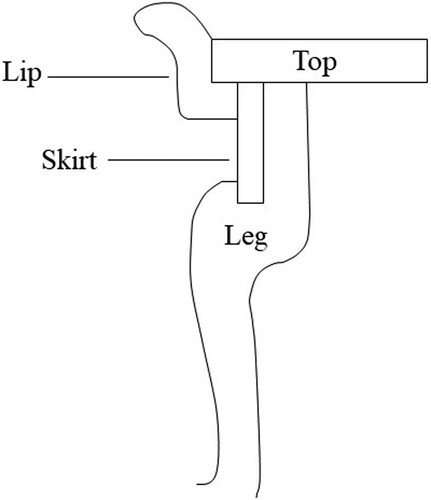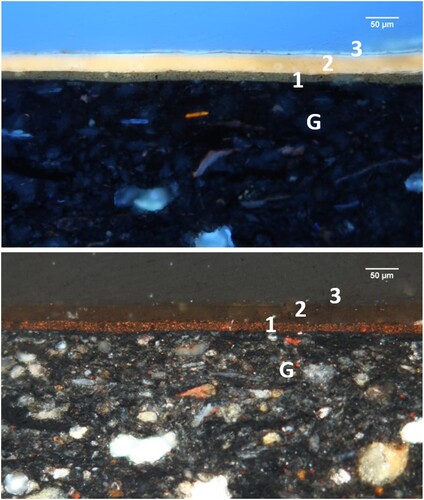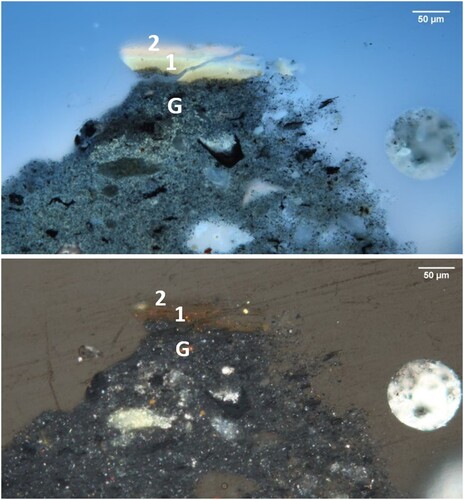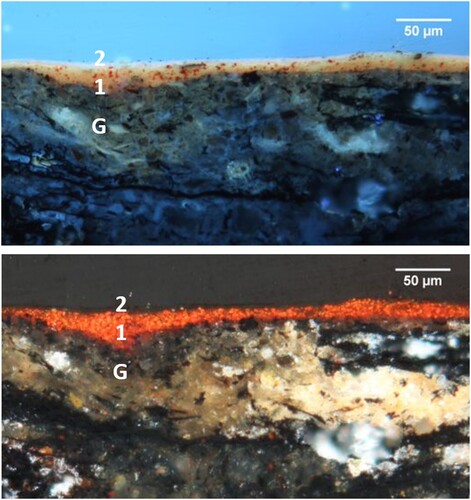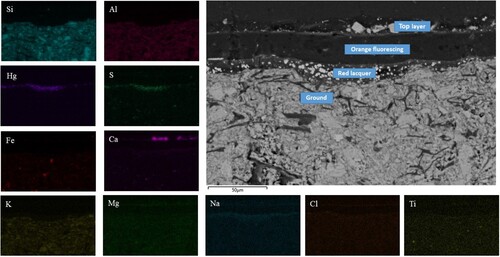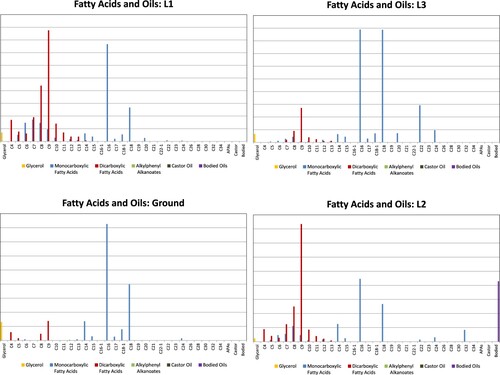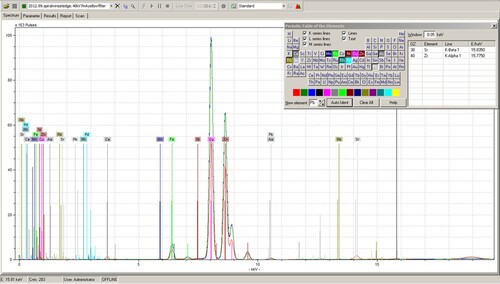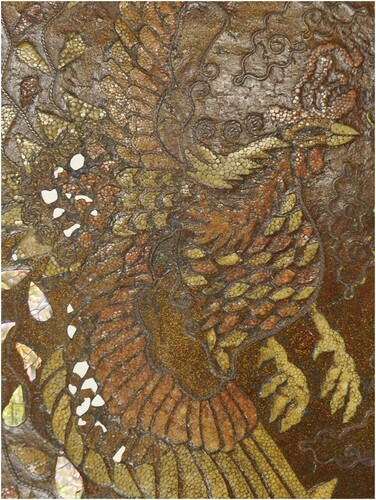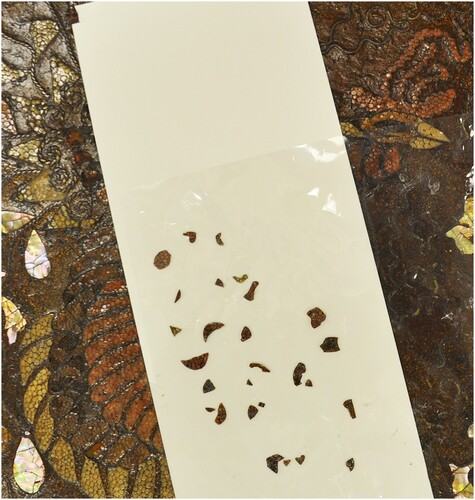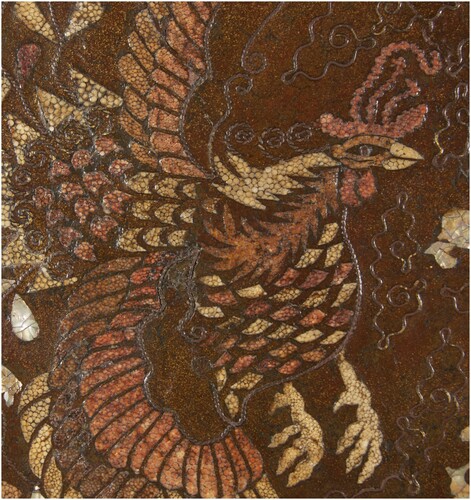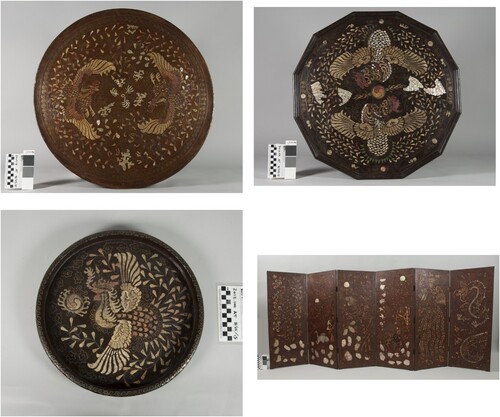ABSTRACT
In-depth studies of the manufacture and composition of late nineteenth century Korean lacquerware from the Joseon dynasty are underrepresented in the English-language literature. This article, the first to offer a comprehensive layer-by-layer analysis of late Joseon dynasty lacquerware, shows that these objects are made using a mixture of traditional lacquerware techniques and materials together with new materials and methods. Through conservation and analysis of four lacquerware objects from the exhibition Mother-of-Pearl Lacquerware from Korea at the Asian Art Museum (29 April–23 October 2016), we identify the materials and techniques used in manufacture and present a new technique to allow conservators to compensate for losses of ray skin inlay. Our discovery that artists used shellac at multiple stages during manufacture calls into question the assumption that shellac was used only as a surface coating. Our findings demonstrate the material and technological complexity of Korean lacquerware from this period and can inform efforts at conservation and analysis of similar objects.
Introduction
Conservators at the Asian Art Museum of San Francisco conducted the examination and treatment of four objects of Korean lacquerware in the museum’s collection in preparation for an exhibition that focused on Korean lacquerware inlaid with mother-of-pearl. Scientists at the Getty Conservation Institute performed analysis to determine the nature of the layers present on the objects. In Korea, lacquerware with mother-of-pearl inlay is called najeon chilgi. The term najeon consists of the character na, referring to shell, and jeon, referring to decorative techniques (Hwang and Kawada Citation2010). Chilgi is the term for lacquering (Kim and Melchar Citation2017). Works that were part of the project include a six-paneled folding screen, a tray, and two tables, all dating from the late nineteenth century during the Joseon dynasty (1392–1910). The objects are decorated with a dizzying array of materials: mother-of-pearl, tortoiseshell, possibly horn, wire, golden-colored flakes, and ray skin inlays. The decorative elements used on the objects follow a long Korean tradition of creating patterns on lacquered surfaces with inlaid elements. Three of the objects feature phoenix birds as the main design element, with beautiful flowing tail feathers. Each panel on the screen depicts a scene from the natural world ().
Figure 1. Before treatment images of each object. Table with phoenix motif, 1850-1950. Korea. Lacquered wood with inlaid mother-of-pearl, ray skin, and metal wire. Asian Art Museum of San Francisco, Acquisition made possible by Korean Art and Culture Committee, 2009.17; (b) Table with phoenix motif, 1850-1910. Korea. Lacquered wood with inlaid mother-of-pearl, ray skin, and metal wire. Asian Art Museum of San Francisco, Gift of Patricia Anloff, 2012.99; (c) Tray with phoenix motif, 1850–1910. Korea. Lacquered wood with inlaid ray skin and brass wire. Asian Art Museum of San Francisco, Gift of Patricia Anloff, 2012.100; (d) Screen with dragon, phoenix, deer, tiger, crane, and peonies, 1850–1950. Korea. Joseon dynasty (1392–1910) or Japanese colonial period (1910–1945). Lacquered wood with inlaid mother-of-pearl, tortoiseshell, brass wire, and ray skin. Asian Art Museum of San Francisco, The Avery Brundage Collection, B61D13. All photographs © Asian Art Museum of San Francisco.
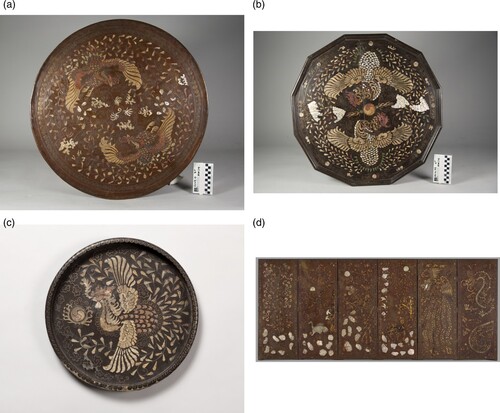
The four objects are described in detail in this article. They form a discrete sample set of materials and techniques used in late nineteenth century Korean lacquerware. The examination, treatment, and analysis of these objects led to insights on technical practices used to create late Joseon dynasty lacquerware. Presenting this layer-by-layer and type-by-type analysis of late Joseon dynasty lacquerware affords information about the distinctive methods in use by some Korean artisans during this time period and allows for comparison with other lacquer-making cultures. In terms of conservation treatment, all loss compensation of the inlay was done by making removable fills. A novel technique for creating fills for ray skin inlay is described in detail.
Examination and treatment were carried out in the Conservation Center at the Asian Art Museum by Colleen O’Shea and Mark Fenn. Analysis and interpretation of the objects’ layers was carried out at the Getty Conservation Institute (GCI) by Herant Khanjian, Michael Schilling, Joy Mazurek, and Art Kaplan.
Description of the objects
Each object has a wooden substrate, a textile layer, a lacquer surface consisting of one or more layers, and many elements of inlay. The inlay materials form designs on the prominent surfaces of the objects and include mother-of-pearl, ray skin, tortoiseshell, wire, golden-colored flakes, and possibly horn. Unlike earlier Korean lacquerware in which mother-of-pearl is the dominant inlay material (Hwang and Kawada Citation2010; Frick, Kieser, and Prüch Citation2019), the two tables and the tray in this study are predominately inlaid with ray skin. The screen has an equal mix of mother-of-pearl, tortoiseshell, and ray skin inlays. compares the decorative features of the objects.
Table 1. Decorative features on the objects.
Decorative techniques
Golden-colored flakes
The round table, twelve-sided table, and screen are all decorated with small golden-colored metal flakes that are distributed within the coating layers of the objects. The method of application of these flakes is likely similar to the Japanese nashiji technique; the word means ‘pear-skin’ and in this case describes an even texture created by sprinkling flat particles of metal onto a still-wet lacquer surface, then securing the flakes by applying layers of transparent lacquer (Ford and Watt Citation1991). We regret that we do not know the Korean term for this technique. Frick writes that the nashiji technique was especially popular in Japan from the sixteenth century and spread after that time to lacquer workshops across East Asia (Frick Citation2012, 188).
Mother-of-pearl inlay
To cut the mother-of-pearl pieces into shapes, craftspeople from the Goryeo through the Joseon dynasties used knives, chisels, engravers, and scissors, or awls, needles, or gimlets to pierce holes. A fretsaw was employed starting in the twentieth century (Kobayashi Citation2012; Yonghee Citation2014).Footnote1 While none of the edges of the mother-of-pearl pieces were accessible to study in these objects, given their date of manufacture, it is likely that they were not cut by fretsaws.
The cut mother-of-pearl pieces on the objects are either applied whole, or were further shaped using the tachalbeop technique, in which curved pieces of mother-of-pearl are struck with a hammer or a knife to flatten them, imparting a cracked texture (Kobayashi Citation2012) ().
Ray skin inlay
Visual analysis based on the morphology of the scales was used to determine that the skin inlay on all the objects is ray skin. Rays have circular placoid scales of variable size, whereas sharks have diamond-shaped placoid scales of uniform size (Willemsen Citation1997).
The top surface of each piece of ray skin inlay on all the objects was sanded prior to use on the objects to create a smooth surface. The underside was likely skived, similar to methods of processing other animal hides, given the resulting thinness of each piece of inlay. Each piece of ray skin inlay is backed with a finely woven plain weave textile attached with a clear adhesive. Identification of the adhesive was not performed. On all four objects, the textiles backing the ray skin pieces are always colored to match the color of the ray skin. The function of this backing textile is unclear. It may be to ensure a consistent surface for adhering to the substrate. The top surface of the ray skin appears whole and intact, with no disruption or space between the placoid scales, so it does not seem that the textile was used to fix the scales in place.
The ray skin inlay was likely processed by dying the skin and textile separately, adhering them together, and then cutting out individual inlay pieces. A less probable option, given that the soaking required for dyeing would likely dissolve the adhesive, is that the ray skin would be adhered to the textile, then the entire ray skin and textile dyed as a unit, and then individual pieces would be cut out. No documentation of this process was found in the English language literature. It is a topic ripe for future investigation. In many instances on these four objects, the ray skin, which has been exposed to light over decades, has faded considerably. The corresponding textile backing is generally much brighter because it was protected from light exposure. Further research into the nature of the dyes is desirable.
Tortoiseshell or horn inlay
The tortoiseshell inlay is also backed with a textile. In areas of lost tortoiseshell inlay on the six-paneled screen, the textile backing is revealed to be a reddish orange or yellow, apparently to enhance the color of the tortoiseshell once it is placed on top. This is a noticeable distinction from tortoiseshell inlay applied during the Goryeo dynasty, when shell from the hawksbill sea turtle (Eretmochelys imbricata)Footnote2 was painted on the reverse in yellow, orange, or red (Frick Citation2012). The technique of applying color to the underside of a thin translucent material is called bokchae (Choi Citation2001).
The solid field of the orange color used for the beaks of the phoenixes on the twelve-sided table suggests that the beaks could be made from horn, painted orange underneath in the tradition of hwaguk, in which strips of ox horn are used as decorative elements (Wright and Pai Citation2000). Alternatively, the beaks could be made from a solid area of color on a piece of tortoiseshell, if the artisan were careful to avoid the brown mottled areas of tortoiseshell. Both beaks were firmly adhered to the table, allowing no access to their back surface. It was therefore not possible to determine whether the beaks were backed with a textile layer. The material used to create the beaks could not be definitively determined during this study.
Wire inlay
Single and twisted wire inlays are used to decorate the surface in one of three ways: they serve as borders to other design elements, e.g. following the curve of the phoenix’s breast, they are embellishments to other design elements, for example, they create a curly surface coming off of the phoenix’s breas; and sometimes they are used to create organic curving shapes that stand alone as design elements. Both types of wires appear to have been abraded after application creating a flat upper surface.
Assembly
Although practices may vary, examination of these objects suggests that the order of operations for their creation proceeded by first making the wooden structure, then adhering a textile base layer, and next attaching the inlay elements. After the inlay elements were attached to the textile base layer, cross-sections from the objects reveal that a bulked lacquer ground layer was applied followed by one or two thin lacquer layers. Careful polishing revealed the design. The dark edges surrounding the placoid scales and in between the pieces of crushed shell support the idea that the lacquer was applied after the inlay. The golden-colored flakes in the coating layers on three of the objects overlay the inlay in places and so this coating layer must have been applied after the inlaid elements were in place. The stratigraphy and nature of the lacquer layers is described in detail in the ‘Analysis’ section below. This corresponds to what is recorded for Goryeo dynasty inlay: mother-of-pearl inlay and tortoiseshell applied first, followed by lacquer bulked with bone powder spread thinly to fill any gaps (Lee Citation2019, 118).
Individual objects
Round table 2009.17Footnote3
This lacquered wooden table is composed of a round top with a raised lip, mounted on a short conical pedestal. The top is made up of three hand-hewn boards glued edge to edge. The conical pedestal is composed of at least two bent boards. Each board has saw cuts on the inside perpendicular to the long axis, spaced roughly an inch apart. These cuts go almost completely through the board so that the board could be bent into a segment of a cone (see ). The joins between the segments appear to be glued; an X-radiograph of one of these shows no nails (see ). In four areas on the pedestal the wood was pierced, forming a manja (cruciform shape)Footnote4 within a circle. The pedestal and top are joined with box nails, finishing nails, and some now-headless nails, most of which pass diagonally from the outside of the pedestal edge into the underside of the top.
Figure 4. X-radiograph of the round table. This section is from the skirt of the table. The thin, nearly equally spaced horizontal lines are the saw cuts in the wood that allow for the table’s round structure. Image © Asian Art Museum of San Francisco. Parameters: 40 kV, 3 mA, 78 s, 40 inches SID.
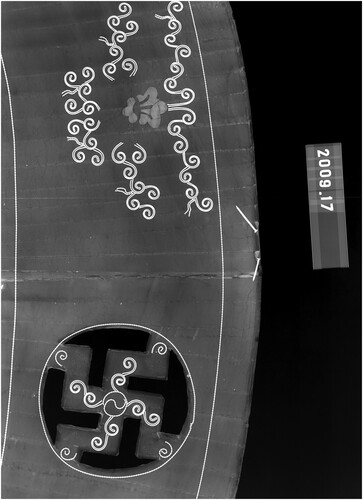
The top of the round table is covered with a textile base layer, followed by a dark gray ground. Ray skin inlay forms a design of two phoenixes. The colors of the ray skin inlay include undyed as well as dyed red, green, and yellow. Each piece of ray skin is backed with a textile. The hammered mother-of-pearl inlay forms indistinct curved shapes. Some of the wire inlay is single strand, while some is a double strand with an S twist. The wire outlines the shape of the birds, creates freeform shapes between the two birds, and encircles the rim. The surface coating layer contains flakes of golden-colored foil. The underside of the top (inside the pedestal) has no textile base layer or ground, just a thin layer of flake-bearing lacquer. The surface fluoresces orange when viewed with ultraviolet (UV) illumination.
On the pedestal, mother-of-pearl, ray skin, and wires are inlaid to create floral peony shapes in the areas between the cut-out circles. The manja shapes themselves are embellished with ray skin and wire inlay in the form of part of the Korean national flag (Taegeukgi) and a yin-yang symbol.
The round table was acquired via a dealer from the Young Ja Kim family in California. Its dimensions are 25.4 cm in height and 69.9 cm in diameter.
Twelve-sided table 2012.99Footnote5
This type of small dining table is referred to as tiger-legged, or hojok-ban, due to the sharply curved shape of the legs (Pai Citation2006). Whereas Pai writes that the top of this style of table would be made of one plank of wood, the top of this table is composed of two edge-joined wooden boards with two transverse battens on the underside (Pai Citation2006, 82). The battens are attached with modern box nails from both top and bottom. The lip is composed of twelve pieces and the skirt of sixteen. The lip and skirt are joined to the edges of the top with square wooden pegs, nails, and adhesive. The upper end of each of the four legs is butted to the underside of the table and secured with adhesive. The skirt is slotted into the shoulder of each leg (see ). The lower end of each of the four legs terminates in a round tenon which fits into one of two parallel stretchers which sit on the floor. The legs appear to be shaped by hand and are not completely smooth. This table is nearly identical to one in the collection at the Los Angeles County Museum of Art (M.2000.15.155). Another table of similar construction, although dissimilar decoration, is in the National Palace Museum, Seoul, with a date of early twentieth century (Gagu68).
The wood substrate of the table top is covered with a textile base layer, then a dark gray ground. Inlays of ray skin (undyed as well as dyed red, orange, yellow, and green colors), mother-of-pearl (whole pieces and hammered [tachalbeop] pieces), wire (single strand and S- and Z-twisted two strand), and a hard orange material that could be horn or tortoiseshell are set into the lacquer layers. Each individual piece of ray skin is lined with a textile. The inlay depicts two large phoenixes along with small symbols of longevity (e.g. fungi, antlers, and gourds) and abstract organic shapes. Fine black detail lines on some of the skin inlay on the phoenixes’ inner wings and the backs of their necks are painted on the surface. Tiny golden-colored flakes are distributed throughout the coating layer. The underside of the top, the lip, the skirt, and the legs have only a very thin, opaque dark brown coating with the small golden flakes distributed throughout. The top fluoresces a pale orange with an overlay of green, especially along the center crack. The underside fluoresces orange; the legs and stretchers mostly pale green with some orange. The areas that fluoresce green correspond to a degraded modern coating that is visibly detectable on some of the table’s surface but was too thin to be sampled.
The twelve-sided table and the tray (2012.99 and 2012.100) were owned by O. Gaylord Marsh, the U.S. Consul General to Korea in the 1930s, and were gifted to the museum by his daughter-in-law, Patricia Anloff. The table is 40.0 cm high, 63.8 cm wide, and 64.5 cm in diameter.
Tray 2012.100Footnote6
The wooden substrate of this round, short walled tray is one piece, likely lathe-turned, though no turning marks remain. Adhered to the bottom of the inside and the outer face of the side wall is a coarse, pale brown plain weave textile. As in the other examples, the ray skin inlay is sanded flat and is either undyed, or dyed red, green, and yellow-orange colors, and is lined with a textile colored to coordinate that of the ray skin. The ray skin forms an image of a phoenix and a tricolored taegeuk (yin-yang) symbol.
Wire inlay (single strand and two strand Z-twisted) forms curved organic shapes in the tray, and a C-scroll pattern along the rim and on the outside of the walls, which also have ray skin inlay.
The tray underside and the inside of the side wall have no textile base layer and only a very thin surface layer of lacquer. Wipe marks are visible on the underside. The surface fluoresces orange when viewed with UV illumination.
The tray has no golden-colored flakes or mother-of-pearl inlay. It is approximately 5 cm in height and 34.3 cm in diameter.
Folding screen B61D13Footnote7
Each of the six panels of this screen is composed of a thin wooden board set into a wooden frame with one vertical and two horizontal cross members on the back. These cross members are hidden by a taut layer of paper to which is glued a coarse, roughly pieced blue textile covering the back of each panel. There are wedged mortise and tenon joints in the corners of the frames of the six panels. Three hinges are used to join each pair of panels. Each hinge is secured with six nails.
The face of each panel is covered with an off-white plain weave base textile and a gray ground, then a reddish-brown coating with golden-colored flakes. Inlay is used to form decorative plant and animal motifs. The inlay is composed of mother-of-pearl, tortoiseshell, ray skin, and wire (single strand and two strand twist, S and Z). The wire is noticeably variable in thickness and degree of twist. The mother-of-pearl inlay is hammered [tachalbeop]. The ray skin is in three colors: undyed, green, and pink (likely faded). Like in the other three objects, each piece of the ray skin inlay is lined with a textile of corresponding color. The proper left panel depicts a dragon, panel 2 has a phoenix design, panel 3 represents deer under bamboo, panel 4 shows a tiger and bamboo, panel 5 depicts birds under a tree, and panel 6 has a plant motif. The surface fluoresces orange.
The folding screen was donated to the museum by its founder, Avery Brundage. The screen measures 216 cm wide x 91 cm high overall; each panel measures 36 cm wide and 91 cm high.
No earlier history of any of these four objects exists in museum records.
Analysis
Methods
Lacquer and ground layers
A set of samples of the lacquer and ground layers was taken from each object for subsequent examination. The samples were embedded in epoxy resin and polished after curing to create cross-sections. Investigation of the samples and cross-sections included optical microscopy and layer by layer sampling for subsequent processing. Pyrolysis-gas chromatography–mass spectrometry using thermally-assisted hydrolysis and methylation (THM-Py-GC–MS) enabled identification of the organic components. Scanning electron microscopy with energy-dispersive X-ray analysis (SEM-EDX) was performed to characterize the inorganic components of the cross-sections. Fourier trans-form infrared spectroscopy (FTIR) was primarily used to investigate the chemical composition of the inorganic components in the thick foundation layers and to determine whether any additional information could be gathered from the organic additives.
Other components
Polarized light microscopy (PLM) was used to characterize fiber samples taken from the textile components, including samples that cover the wood substrate and those that line the ray skin inlay. X-ray fluorescence (XRF) spectrometry was used to analyze the golden-colored wires and flakes on all objects.
Complete experimental procedures and parameters are provided in the experimental appendix.
Results
Layer structure and composition
Round table ()
The whitish ground (G) is a mixture of quartz, clay minerals, and coarse charcoal fragments. The red lacquer layer (1) ranges in thickness from 3 to 5 µm and contains a mixture of red and small black particles. A thin, dark boundary line is present between (1) and (2), and no penetration of (2) into (1) is observed. An ultraviolet-induced (UV) orange fluorescing layer (2) is approximately 30 µm thick, and the top brownish layer (3) ranges in thickness from 5 to 20 µm. The few particles embedded in the top layer (3) were identified in SEM-EDX analysis as containing calcium, silicon, aluminum, and iron, among other elements, and are included in the elemental composition column in . The origin and purpose of the components could not be ascertained but it is likely that they were introduced through cross-contamination during the preparation of the top coating layer.
Figure 6. Cross-section photomicrographs under visible (below) and ultraviolet light (top) showing layers from the round table. Photomicrographs by Herant Khanjian.
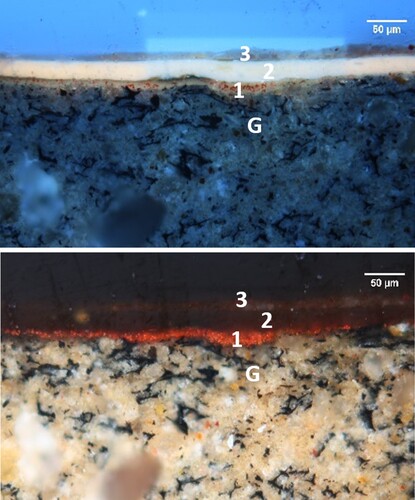
Table 2. Summary of SEM-EDX results.
Twelve-sided table ()
The black ground layer (G) is a mixture of quartz, clay minerals, and charcoal powder. The red lacquer layer (1) is approximately 10 μm thick, contains red and small black particles, and shows no penetration of (2) into it. No cracks were observed in that layer. The orange-fluorescing layer (2) is approximately 30 μm thick, and the boundary between (1) and (2) is not perfectly smooth as the lacquer surface appears uneven. A bluish-gray fluorescing top layer (3) is a few microns thick. A small area showing separation between (2) and (1) is likely due to sampling or the embedding procedure.
Tray ()
The black ground (G) is a mixture of quartz, clay minerals, and powdered charcoal. The red lacquer layer (1) is approximately 20 μm thick, with superficial horizontal and diagonal cracking. The orange-fluorescing layer (2) is approximately 15 μm thick. No penetration of (2) into (1) is observed. The cross-section has a visible diagonal crack propagating through the top two layers, partly due to the fragility of thin upper layers.
Folding screen ()
The whitish ground layer is a mixture of quartz, clay minerals, and coarse charcoal fragments. The red lacquer layer (1) ranges in thickness from 3 to 30 μm, with no penetration of (2) into it. The pink-fluorescing layer (2) is approximately 7 μm thick.
FTIR analysis of ground layers
The results of analysis from representative ground layers show the presence of silicaceous components such as quartz and clay minerals (). The presence of clay is indicated by the Si–O stretching bands at 1045 and 1011 cm−1, O–H group stretching vibrations between 3700 and 3620 cm−1, and O–H bending vibrations at 913 cm−1. The Si–O–Si stretching bands located at 1076, 798, and 780 cm−1 are assigned to quartz.
Figure 10. FTIR spectrum of the foundation layer from the round table and matching reference spectra.

In comparison, the concentration of the organic components is lower, based on the presence of distinct bands attributed to proteinaceous material. However, spectral amplification of the relevant peaks enabled the identification of proteins based on the presence of carbonyl C = O stretching band at 1651 cm−1, C–N stretching band at 1544 cm−1, C–H band at 1452 cm−1, and N–H/O–H stretching bands at 3300 cm−1. Infrared band intensities of proteinaceous materials vary with the layer composition.
Elemental analysis and imaging by SEM-EDX
The elemental distribution within the spectral profile for each sample layer is listed in . The major components are bolded, minor components are in italics, and trace components are in regular type. The elements silicon and aluminum are present in all layers, suggesting contamination from the thick ground layer. The elemental mapping example from the round table cross-section highlights the composition of the major components detected in each layer (). In total, four distinct layers can be identified using SEM-EDX analysis. The low backscatter intensity of the orange-fluorescing layer and top layer is typical for organic-rich layers. The top layer contains aluminum, silicon, and calcium, in addition to several trace components. The red layers in the round table and folding screen contain mercury and sulfur, consistent with the pigment vermillion. Iron present in the red layer of the twelve-sided table is indicative of iron oxide red pigment. The ground layer contains several components including aluminum, silicon, potassium, sodium, and iron, which are consistent with clay and silicaceous minerals. There appear to be similarities regarding the type of elements detected in the lacquer- and shellac-containing layers in each object. However, it is difficult to ascertain whether this is inherent to the raw material used by the artist or as a result of contamination from sampling. This observation is further complicated by the elemental similarities between the ground and lacquer layers.
Organic components detected by THM-Py-GC–MS
THM-Py-GC–MS permits identification of a range of organic materials used in the creation of Asian lacquered objects. These include catechol-rich saps from trees in the Anacardiaceae family and a range of additives such as drying oils, natural resins, proteins, carbohydrates, and waxes. The three common sources of sap for Asian lacquer are: the Toxicodendron vernicifluum tree which grows in China, Japan, and Korea and produces urushiol, known as ottchil lacquer in Korea; Toxicodendron succedaneum, which grows in Vietnam and Taiwan, and produces laccol lacquer; and Gluta usitata and Gluta laccifera, native to Myanmar, Thailand, and Cambodia, are sources of thitsi lacquer (Heginbotham and Schilling Citation2011; Sung, Lu, and Miyakoshi Citation2015). We will refer to these tree species as Anacards.
Catechol-rich Anacard saps were identified in the red layer from all four objects. Ottchil was identified in the round table, twelve-sided table, and folding screen based on the presence of the C15 catechol and the C8 acid catechol (mazzeic acid) (Niimura et al. Citation1999; Niimura and Miyakoshi Citation2000; Honda et al. Citation2010; Schilling et al. Citation2016). Laccol was identified in the tray based on the presence of the C17 catechol and the C10 acid catechol (arlenic acid). shows the gestalt graph of the Anacard markers of the red layer from the twelve-sided table, which shows a mixture of ottchil and laccol was used.
Figure 12. Gestalt graph of Anacard markers for the twelve-sided table, which shows the presence of ottchil and laccol.
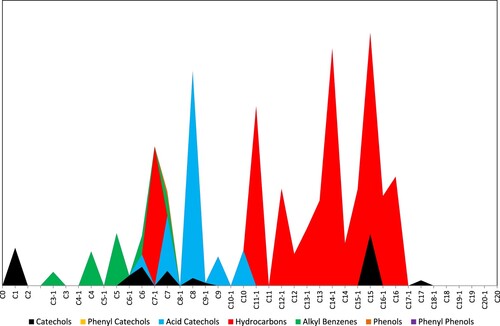
Drying oils, present in every layer, are often the major component. They are identified by the presence of glycerol, a homologous series of dicarboxylic fatty acids with C9 as the most abundant member, and saturated fatty acids. Drying oils are common additives in lacquered objects from throughout Asia (Schilling et al. Citation2016). shows the distribution of drying oil marker compounds in the four layers from the twelve-sided table.
Shellac was identified by the presence of aleuritic, laccishellolic, and shellolic acid methyl ester markers (Sutherland and del Rio Citation2014) in various different layers across the four objects. See for complete details. The shellac contains wax esters characteristic of shellac wax (fatty acid esters of fatty alcohols with the most abundant alcohol being C28).
Table 3. Layer-by-layer composition.
The ground layers of the objects were found to contain a number of materials. Glue was the primary component detected in all the ground layers based on a set of pyrolysis markers (largely methyl pyrrole and di-keto peptides); trace levels of starch markers (mainly schellmannose) are also present (Schilling et al. Citation2016). Phosphate (identified as trimethyl phosphate) is present in the ground layers of the round table and the folding screen and may originate from bone.
A number of marker compounds can be attributed to the presence of charcoal in the layer samples. For example, the Pinaceae markers methyl dehydroabietate, tetradehydroabietic acid, and oxodehydroabietic acid methyl esters (Pastorova et al. Citation1997; van Keulen Citation2014) were identified in all four red layers in addition to the ground layers of the twelve-sided table, the tray, and the folding screen.
Wire and flake inlays
XRF indicated that the wires and metal flakes are primarily composed of copper and zinc, identifying them as brass. The composition of the wire is consistent with those published for Goryeo dynasty wires (Lee Citation2016; Lee and Fitski Citation2018). A representative spectrum is provided in . The iron peak likely results from the pigment in the lacquer surrounding the wire.
Textiles
Fibers from the textile base layer and from the ray skin backing were sampled on each object. Features present when examined with PLM indicated that all of the fibers sampled are bast fibers, likely ramie or hemp. Both plant sources are indigenous to Korea (Hwang Citation2010). The fibers are long and flat, with cross-markings and striations. Further analysis, perhaps with cross-sections or by following the method described by Bergfjord and Holst for differentiating between bast fibers (Citation2010), would be necessary to positively differentiate between the two fibers.
Summary of analysis and discussion
The composition of the layers on each object is summarized in . The comparison of the analytical results from the four objects indicates a common manufacturing process for the period, with a similar range of compositional materials used during the latter half of the nineteenth century.
The ground layers of the four objects were bound with animal glue and drying oil and were darkened with charcoal (powder or fragments). No Anacard lacquer was detected in any of the ground layers. Shellac was found in the ground layers of the twelve-sided table and the screen. The grounds of the round table and the folding screen both include crushed bone, while the twelve-sided table and the tray do not. Across all four objects, only the red layer (over the ground) contains Anacard lacquer.
The round table and folding screen are colored primarily by vermilion and charcoal in the lacquer-containing layer, which is ottchil for both objects. The lacquer on the twelve-sided table and the tray, in contrast, is pigmented by iron oxide and charcoal. On the twelve-sided table, this layer contains ottchil with some laccol, whereas the lacquer on the tray consists solely of laccol. The upper layers on all objects contain shellac and drying oil.
The results provide some intriguing insights into lacquerware production given the expectation that Asian lacquerware typically contains more than one layer of Anacard lacquer. The ground layers, as illustrated by the cross-section photomicrographs, are very thick, which contrasts with the extremely thin lacquer-containing layer on top of the ground. It is possible that ottchil and laccol were used sparingly if expense and availability of these materials were challenges in this time period, though both factors are unknown to the authors. The English-language literature suggests that the quality of Korean lacquerware declined in the latter half of the nineteenth century (Hwang and Kawada Citation2010; Frick Citation2012). The analysis seems to corroborate this observation.
Another important detail revealed by the analysis is that the brown color seen in all the objects is the result of a combination of either vermilion or iron oxide red with charcoal. The color would also appear darker because the pigmented lacquer layer was applied over ground layers darkened with charcoal. The use of vermilion on the round table and the screen may explain their warm brown appearance. The twelve-sided table and the tray are pigmented with iron oxide red, by contrast, and their visual appearance is a darker brown. We note that the two objects on which we found ottchil – the folding screen and the round table – also used vermilion as a red pigment, not iron oxide red. Vermilion and ottchil are both more expensive raw materials, possibly making these two objects more expensive and/or intended for a more privileged clientele.
The ubiquity of shellac and drying oil, especially the frequency of the combination of shellac and drying oil, in the manufacture of all four objects was somewhat surprising. These materials are immiscible. We have found no other explanation in the literature or in our own laboratory practice of how the two materials could be well-combined apart from something akin to the French polish technique, which is used to create glossy coatings on furniture and musical instruments and is predominately found in Europe at this time. This technique is described in detail in Rivers and Umney (Citation2003); a summary is that shellac dissolved in alcohol is applied in successive layers in order to build up a glossy and level surface. Some practitioners apply oil to the wood as a preliminary step.
In contrast, our close examination of the cross-sections on the subjects of this article detected scant evidence of dirt or cracking in the interface between the shellac layers and the lacquer-containing layer. This suggests that these shellac layers are original.
The presence of shellac in the ground layers of the folding screen and twelve-sided table also indicates that shellac was in use at the time of the object’s creation. Early examples of shellac-containing grounds are the ca. seventeenth century Japanese lacquered panels on the commode by Bernard II Van Risemburgh in the Getty Museum’s collection (65.DA.4) (Heginbotham and Schilling Citation2011). Another example of shellac found in ground and other layers is a Burmese shrine, circa 1860–1880, at the Victoria and Albert Museum (IS.11-69) (Risdonne et al. Citation2018). Wang, Chen, and Tamburini Citation2020 indicate that a Chinese Tang dynasty (618-906) bronze mirror at the British Museum (1973,0726.62) has a combination of shellac and drying oil as its original upper layer.
Other scholarship has referred to finding shellac layers on lacquerware as ‘coatings,’ for example, Kim and Melchar (Citation2017). These authors describe that some of the Korean lacquerware in the collection of the Victoria & Albert Museum in London was found to have shellac coatings, most notably on a tiered box, made circa 1550–1599 (accession number W:43:1-1938). They presume the shellac to be a later addition (Kim and Melchar Citation2017). Other examples of shellac as a ‘coating’ on lacquerware were also described thus on an eighteenth-century Chinese imperial carved screen in the collection of the Weltmuseum Wien (71.233) in Pitthard et al. (Citation2016) and a Chinese export circular center table circa 1850 in the Winterthur Museum’s collection (1963.0096) (Petisca et al. Citation2016).
All four objects were found to have bast fiber textiles (either hemp or ramie), brass wires and flakes, and ray skin inlay. The shell was not characterized in this study due to lack of access.
Conservation treatment
Condition
Round table
The edge of the top had been heavily damaged and received an earlier repair campaign with lacquer, nails, fills, and overpaint in three areas. At the time of examination, these areas appeared worn, chipped, and dented all over. The finish appeared dull.
There were losses of the ray skin, especially in the wing of one of the phoenixes. One large loss in one of the triangles at the right side of the base of the tail of one phoenix was filled with a pale, yellow-brown material (possibly wood putty). The inlay wire was lifting in places, especially in the center of this same bird, where an attempt to re-adhere it with a flexible, translucent reddish brown adhesive had failed. There were many small losses of the lacquer layer, exposing a dull yellowish layer bulked with many small black shards.
Twelve-sided table
The join between the two boards of the top was cracked (probably due to shrinkage of the wood) with many small losses of the overlying lacquer, resulting in a very prominent split running along the center of the table. Each of the boards was also cracked near the outer edge, and in one case the crack extended through the lacquer layer. Many of the other joins also had shrinkage cracking. The toe of one leg was missing.
There were losses of ray skin, especially in the head of one of the phoenixes. The possible horn/tortoiseshell (the lower bill of this same bird) inlay and two of the brass spirals were missing. The brass wires were loose where they crossed cracks in the lacquer.
Tray
The wooden core of this tray was sound, but the overlying layers were heavily damaged. The textile layer on approximately 1/4 of the outer side wall was detached from the wooden substrate and much of the lacquer and inlay on it is lost. There were also large losses of inlay in the interior of the tray, including the phoenix's beak, wattles, and the back of the comb, and losses of lacquer between the inlay, especially ahead of the bird's left wing tip. There were other scattered losses of lacquer, especially on the inner upper edge of the side wall. The ray skin inlay was warped, tented, and lifting, especially on the bird's head, neck, and breast. The lacquer around the head is wrinkled. A piece of twisted wire was now anchored only in a hole in the wooden substrate at the base of the beak, though it probably once served as the dividing line between the top of the head and the comb. Various other wires were lifting and lost. The dyed skin is heavily faded.
Folding screen
Condition issues for the screen generally consisted of long vertical cracks in the lacquered surface, lifting inlay, losses of lacquer and inlay, and scattered various dull brown and uneven repair fills.
Treatment
All of the objects in this project required stabilizing losses and lifting inlay, replacing lost lacquer and inlay, and minor surface cleaning. The goals of the treatment were to preserve original surfaces and allow the beauty of the design and its execution to be seen. This section will focus on a novel technique for filling losses in ray skin. Other aspects of the treatment that we carried out are not included here.
Loss compensation for ray skin inlay
Replacing the lost ray skin was a particular challenge because of its thinness, and the fact that among the many pieces of ray skin across the four objects, there are subtle differences in color, slight differences in texture, and differences in scale size from color to color.
Several options were considered to fill the losses in the ray skin. Other conservators working with ray skin have taken casts of ray skin and created molds from the casting (Schneider Citation2001; Silverman Citation2015). Because the ray skin on these objects is extremely thin, test castings were too fragile to be handled. Additionally, due to the difference in scale size across different colors of skin, taking molds from correctly sized scale sections for each color and area of loss would have been too time-consuming. Making an in situ fill with any putty-like material would have required carving and shaving down the putty to make it level with the object’s surface, which could have endangered the surrounding lacquer. We attempted to use digital printouts of the existing ray skin; however, the difficulty of matching the color for each individual loss proved too time-consuming and produced unsatisfactory results. Additionally, the variance in size of the ray skin scales from color to color proved a formidable obstacle in terms of trying to match the scale for so many small losses.
Testing of digital printouts revealed that paper was an ideal fill material. Acid-free paper matches the thinness of material required, possesses the necessary archival qualities, and can be colored to match each individual loss. Once imparted with texture, the paper fill can be attached to the surface of the object using a conservation-grade adhesive. The fill can easily be removed, if need be, by applying a solvent to the edges of the fill, thus dissolving the adhesive.
Ultimately, making paper fills by hand proved to be the best solution. The method here is similar to the one described in Chao Citation2016 and Silverman Citation2015. A tracing of each loss was made using a piece of Mylar. This was used as a template for cutting the shape out of paper (). Once the shape was cut, the piece was toned to match the surrounding ray skin using acrylic paint. Metal syringe tips of various diameters stamped onto the paper with a rawhide mallet simulated the texture of the ray skin scales. The resulting circles were outlined with a Micron pen. Clear acrylic gloss was then painted on to match the sheen of the surrounding areas (). A sealant layer of dilute Paraloid® B-72 in acetone was first applied to each area of ray skin loss. The paper fill was then adhered in place with concentrated Paraloid® B-72 in acetone. The fills were covered with a sheet of silicone release Mylar and burnished. The resulting fills now blend into the surrounding surface ().
Conclusions
Close examination of this group of four inlaid late Joseon dynasty lacquerware objects () provides a better understanding of the materials and techniques used in their creation. On all the objects in this study, ray skin inlay is the dominant feature. Mother-of-pearl inlay, where used, serves as more of an accent (with the exception of the screen). The change in dominance between ray skin and mother-of-pearl is touched on in Hwang and Kawada Citation2010, although the factors compelling this change remain unclear: taste, price, or availability of shell could all be possible reasons.
Construction of the wooden forms themselves varied somewhat from what was reported in the literature. Interventions evident from variations in hardware used could be seen in the X-radiographs. Further work could be done to identify the types of wood used to make these objects. Each object was covered with a textile base layer before the lacquer layers were applied. This contrasts with other studies published that have described textile base layers as rare in late Joseon objects, e.g. Hwang and Kawada Citation2010.
Losses in the various inlays revealed clues as to the manufacturing process. In the case of the ray skin inlay and the tortoiseshell inlay, all pieces that were available for observation proved to be lined with textiles. This introduces new questions about how and when the textile lining was attached to the inlay material: pre- or post-cutting into small pieces, and, in the case of the ray skin, whether the dyeing of the ray skin and textile was done with the two materials simultaneously or separately.
Wire styles are either single strand plain or two-strand twisted. The wires and the golden-colored flakes are all found to be composed of copper and zinc.
Because the objects in this study depend on inlay elements for their visual impact, treatment techniques focused primarily on compensation for lost inlay. In almost all cases, removable fill materials were used. A new technique of using paper imparted with texture as a fill for ray skin provides a visually satisfying result.
Layer-by-layer analysis of the cross-sections provided critical information that would likely have been missed if only the surfaces had been sampled. The ground layers consist of clay, quartz, charcoal, animal glue, and drying oil. Shellac was found in the ground layers of the twelve-sided table and the folding screen. The grounds on the round table and folding screen also include crushed bone. The objects were found to have only two or three layers above the ground layer, in contrast to expectations that lacquered objects have many layers of lacquer. On all four objects, the only layer that contains Anacard lacquer is the red pigmented layer directly above the ground. The red pigments are either iron oxide red (twelve-sided table and tray) or vermilion (round table and screen). All other layers contain shellac and drying oil.
The four objects form a discrete sample set, and this close study raises more questions. What was happening at this time in the Joseon dynasty such that lacquer artists were using scant amounts of Anacard lacquer? Hwang Citation2012 describes that economic growth in the nineteenth centuries led to a new wealthy class, which drove an increase in demand for mother-of-pearl lacquerware – previously only affordable for the aristocracy. This meant a huge increase in the quantities of lacquerware created and accounts for the prevalence of late Joseon period mother-of-pearl lacquerware in existence today (Hwang Citation2012, 59). Did the increased demand result in a shortage of materials, or was this a choice made by artists to stretch their supplies? How were the shellac and drying oil combined to minimize their incompatibility? What drove the switch to shellac for use in the upper layers? Applying layers of shellac to achieve a glossy surface is much less time-consuming than the traditional practice of applying layers of lacquer, which requires extensive polishing between layers. Was it a time-saving choice alone, or a cost-saving choice that drove this change? How common are shellac layers in other late Joseon wares?
What we found overall on these later Joseon objects is a deep connection to traditional lacquerware practices, despite incorporating materials that we were not expecting, for example, the layers of shellac and drying oil. The artists are still applying textile base layers over the wood, still applying bulked grounds, and are still using Anacard lacquers (albeit in small amounts). The practice of applying successive layers to create a glossy and even surface remains the desired final product – but in the case of these objects, the layers of gloss are created by shellac rather than lacquer.
We hope that other institutions will publish similar layer-by-layer analysis of their late Joseon dynasty inlaid lacquer objects to help answer some of these intriguing questions.
Results from this study were shared at a 21 May 2016 symposium, Looking at Mother-of-Pearl Lacquerware from Korea. The symposium was held in conjunction with the exhibit Mother-of-Pearl Lacquerware from Korea, on view from April to October 2016 at the Asian Art Museum of San Francisco. A short film was shown in conjunction with the exhibition.Footnote8 The exhibition included examples of Korean mother-of-pearl lacquerware from the Goryeo dynasty to contemporary lacquerware from artists including Hwang Samyong and Kim Youson.
Experimental appendix
Microscopy
Optical microscopy
Examination of embedded and polished cross-sections was performed under visible and ultraviolet (UV) light, and with an excitation filter cube (I3) for blue light illumination, using a Leica DM4000M optical microscope coupled to a Canon EDS-6D digital camera. The visual information in the form of printed photomicrographs was later used as a guide during the unpacking of the individual layers.
Polarized light microscopy
Polarized light microscopy using plane and crossed polarizers was performed with a Nikon Eclipse microscope.
SEM-EDX
The lacquer cross-sections were analyzed by SEM using an FEI-Philips XL30 ESEM-FEG with an Oxford XMax80 EDS detector and AZtec software. Two sets of analyses were performed to identify the elemental compositions of each distinct layer. SEM-EDX analysis of selected spots across the cross-section were performed under high vacuum at 800 times magnification using the backscatter detector. EDX spectra of individual spots were collected using 15 kV acceleration voltage for 30 s per spot. In addition, imaging and SEM-EDX mapping of a rectangular region of the cross-section encompassing all the layers was conducted using 20 kV for a total acquisition time of 100 min.
FTIR
A stereomicroscope was initially used to examine the sample composition and stratigraphy. Representative particles were removed from the ground layer and placed on a one-millimeter-thick diamond window. The particles were then flattened to a translucent layer using a metal roller. Analysis was performed on the resultant flattened sample using a 15X Schwarzschild objective, attached to a Bruker Hyperion 3000 FTIR microscope purged with dry air. The samples were analyzed individually using a transmitted infrared beam apertured to approximately 200 × 200 micrometers. Polarizing filters were used to enhance sample contrast and assist in targeted analysis of the various components. The spectra are the sum of 64 scans at a resolution of 4 cm−1. The identification of the infrared spectral data was performed with the help of in-house generated reference libraries.
XRF
A Bruker Tracer hand-held spectrometer with rhodium tube excitation and silicon p-type intrinsic n-type (PIN) detector was used. The instrument was operated at 40 kV and 17 µA with a yellow filter for 120 s. The spot size was approximately 8 cm. Spectral interpretation was performed using the Bruker Artax Control software.
Layer-by-layer sampling
Unpacking of free sample fragments for Py-GC–MS analysis was performed with the help of a #15 surgical scalpel blade or a micro-chisel. Selected samples ranging in size from 1 × 1 to 2 × 2 mm were adhered onto glass slides, in the right-side-up position, using a cyanoacrylate-based adhesive and allowed to stand for several hours to harden. The unpacking was conducted layer by layer under a Wild Heerbrugg stereomicroscope with the aid of two Labino UVG2 spotlights. Enough material, typically in the range of 50–100 µg, was removed and placed in a depression microscope slide for subsequent Py-GC-MS analysis.
THM-Py-GC–MS
The layers in the samples were analyzed by pyrolysis-gas chromatography–mass spectrometry using thermally-assisted hydrolysis and methylation (THM-Py-GC–MS). Samples (ranging from 0.05 to 0.15 mg) were placed into a 50 µl stainless steel Eco-cup, and two microliters of a 25% methanolic solution of TMAH (Aldrich, USA) were introduced for derivatization to convert labile compounds to more volatile products.
A Frontier Lab PY-2020D double-shot pyrolyzer system was used for pyrolysis, which was performed at 550°C, with the interface maintained at 320°C. The pyrolyzer was attached to an Agilent Technologies 5975C inert MSD/7890A gas chromatograph–mass spectrometer. The split injector was set to 290°C with a split ratio of 20:1 and no solvent delay. An Agilent J&W Ultra-inert DB-5MS capillary column was used for the separation (20 M × 0.18 mm × 0.18 µm). Helium carrier gas was set to 0.9 ml/min. The GC oven temperature program was: 35°C for 1.5 min; 60°C/min to 100°C; 14°C/min to 250°C; 6°C/min to 315°C; 1.5-min isothermal. The MS transfer line was at 250°C, the source at 220°C, and the MS quad at 150°C. The mass spectrometer was scanned from 12 to 600 amu. Some tests were conducted with an Agilent Thermal Separation Probe for pyrolysis at 450°C and splitless injection with a solvent delay of 4.5 min.
Data interpretation was carried out using ESCAPE (Expert System for Characterization using AMDIS Plus Excel), which was developed by the GCI during its research on Asian lacquer analysis (Schilling et al. Citation2016).
Acknowledgements
The study, treatment, exhibition, and symposium were funded by a grant from the Overseas Korean Cultural Heritage Foundation and the authors extend their gratitude to the OKCHF for supporting this work. The authors wish to thank Katie Holbrow for her role in writing and securing the grant. At the Asian Art Museum: the good humor and assistance of all members of the conservation department was a massive contribution to the project’s success. This includes Denise Migdail, Shiho Sasaki, Courtney Helion, and Lisa Lee. The authors also extend deep appreciation to the curatorial department of Korean art, with particular gratitude to Hyonjeong Kim Han, and assistants Silvia Chang, Hannah M. Yoo, Jinhyup Song, and Lisa Shin. Lorraine Goodwin at the Asian Art Museum and the team at 32 K Productions were instrumental in creating an engaging video component of this examination and treatment. Many thanks are offered to Arlen Heginbotham (Getty Museum), Marianne Webb (Webb Conservation), Catherine Matsen (Winterthur Museum), Jing Han (Shanghai University), and Sylvia Miklin-Kniefacz (private conservator) for their consultations during the preparation of this article.
Disclosure statement
No potential conflict of interest was reported by the author(s).
Additional information
Funding
Notes
1 From the late twentieth century to the present, mother-of-pearl pieces could be cut by fretsaw or by laser machines once these became available (Sunhwa Kim, email to the author, 24 March 2020).
2 Regarded as critically endangered on the ICUN Red List since 1996. https://www.iucnredlist.org/species/8005/12881238#assessment-information
4 This symbol is generally referred to as a swastika. We are using the Korean word for this symbol and will alternatively refer to it as a ‘cruciform shape’ in order to avoid any confusion with the symbol’s appropriation by the Nazi Party in twentieth century history.
References
- Bergfjord, C., and B. Holst. 2010. “A Procedure for Identifying Textile Bast Fibres Using Microscopy: Flax, Nettle/Ramie, Hemp and Jute.” Ultramicroscopy 110 (9): 1192–1197.
- Chao, R. 2016. “Compensation for Small Losses to Lacquer and Inlaid Decoration Using Paper Fills Painted and Glazed in Situ.” Studies in Conservation 61 (sup3): 149–154.
- Choi, Y. 2001. “Goryeo Dynasty Lacquerware with Mother-of-Pearl Inlay.” Originally published in Misulsa Yōn’gu (Journal of Art History) 15: 75-108. Translated by Susan Lee. Accessed via https://archive.asia.si.edu/publications/korean-ceramics/essays.php.
- Ford, B. B., and J. C. Y Watt. 1991. East Asian Lacquer: The Florence and Herbert Irving Collection. New York: Metropolitan Museum of Art.
- Frick, P. 2012. “Refined Craftsmanship and Exquisite Beauty—The art of Lacquerwork in the Goryeo Dynasty.” In Korean Lacquer Art: Aesthetic Perfection, edited by P. Frick, and S. Jung, 34–55. Chicago: University of Chicago Press distributed for Hirmer Publishers.
- Frick, P., A. Kieser, and M. Prüch. 2019. “Introduction.” In Production, Distribution, and Appreciation: New Aspects of East Asian Lacquerware, edited by P. Frick, and A. Kieser, 1–9. Leiden; Boston: Brill.
- Heginbotham, A., and M. Schilling. 2011. “New Evidence for the use of Southeast Asian raw Materials in Seventeenth-Century Japanese Export Lacquer.” In East Asian Lacquer: Material Culture, Science and Conservation, edited by S. Rivers, R. Faulkner, and B. Pretzel, 92–106. London: Archetype Publications.
- Honda, T., R. Lu, N. Kitano, Y. Kamiya, and T. Miyakoshi. 2010. “Applied Analysis and Identification of Ancient Lacquer Based on Pyrolysis-Gas Chromatography/Mass Spectrometry.” Journal of Applied Polymer Science 118: 897–901.
- Hwang, M. S. 2010. “Morphological Differences Between Ramie and Hemp: How These Characteristics Developed Different Procedures in Bast Fiber Producing Industry.” Textile Society of America Symposium Proceedings 23. Accessed 3/2/2021 via https://digitalcommons.unl.edu/tsaconf/23.
- Hwang, J. 2012. “Tradition and Development – Lacquerwork with Mother-of-Pearl Inlay in the Joseon Period.” In Korean Lacquer Art: Aesthetic Perfection, edited by Patricia F., and S. Jung, 56–71. Chicago: University of Chicago Press distributed for Hirmer Publishers.
- Hwang, J., and S. Kawada. 2010. Korean Lacquerware Inlaid with Mother-of-Pearl: The Everlasting Beauty. Translated by T. Atkinson. Seoul: National Museum of Korea.
- Kim, R., and D. Melchar. 2017. “Conservation of Korean Najeon Chilgi at the Victoria and Albert Museum: Reviving the Long-Lost Lustre.” Arts of Asia 47 (Sept-Oct): 63–71.
- Kobayashi, K. 2012. “Turban Snails and Abalone Shells – The Technique of Mother-of-Pearl Inlay on the Korean Peninsula.” In Korean Lacquer Art: Aesthetic Perfection, edited by P. Frick, and S. Jung, 72–83. Chicago: University of Chicago Press distributed for Hirmer Publishers.
- Lee, N. 2016. “A Goryeo Dynasty Incense Box with Mother-of-Pearl Inlay.” Orientations 47 (1): 8–11.
- Lee, N. 2019. “A Technical Analysis of a Goryeo-Dynasty Lacquer Incense Box in the Collection of the National Museum of Korea.” In Production, Distribution, and Appreciation: New Aspects of East Asian Lacquerware, edited by P. Frick, and A. Kieser, 107–124. Leiden: Brill.
- Lee, N., and M. Fitski. 2018. “Manufacture and Date of a Goryeo Dynasty Sutra Box with Mother-of-Pearl Inlaid Decoration at the Rijksmuseum, Amsterdam.” Studies in Conservation 63 (3): 163–170.
- Niimura, N., and T. Miyakoshi. 2000. “Identification of Oriental Lacquer Films Using Pyrolysis-Gas Chromatography/Mass Spectrometry.” In Japanische und Europäische Lackarbeiten: Rezeption, Adaption, Restaurierung/ Japanese and European Lacquerware: Adoption, Adaptation, Conservation, edited by M. Kühlenthal, 123–134. Munich: Bayerischen Landesamtes fur Denkmalpflege.
- Niimura, N., T. Miyakoshi, J. Onodera, and T. Higuchi. 1999. “Identification of Ancient Lacquer Film Using Two-Stage Pyrolysis-Gas Chromatography/Mass Spectrometry.” Archaeometry 41 (1): 137–149.
- Pai, M. 2006. Dining Tables: Korean Traditional Handicrafts. Translated by Kyong-hee Lee. Seoul: Ewha Womans University.
- Pastorova, I., K. J. van der Berg, J. J. Boon, and J. W. Verhoeven. 1997. “Analysis of Oxidised Diterpenoid Acids Using Thermally Assisted Methylation with TMAH.” Journal of Analytical and Applied Pyrolysis 43 (1): 41–57.
- Petisca, M. J., S. Auffret, C. Matsen, W. C. Petersen, J. Mass, and M. Anderson. 2016. “A Hint of Orient in an Americana Collection: Investigations Into Chinese Export Furniture at Winterthur Museum.” Studies in Conservation 61 (supp3): 85–90.
- Pitthard, V., S. Stanek, M. Griesser, C. Jordan, S. Miklin-Kniefacz, and R. Miklin. 2016. “The Technical Investigation of an Eighteenth-Century Chinese Imperial Carved Lacquer Screen and its Role in Developing an Appropriate Conservation Treatment.” Studies in Conservation 61 (supp3): 97–108.
- Risdonne, V., L. Burgio, M. R. Schilling, and H. Khanjian. 2018. “Investigation of Burmese Lacquer Methods: Technical Examination of the V&A Burmese Shrine.” Journal of Cultural Heritage 30 (March-April 2018): 16–25.
- Rivers, S., and N. Umney. 2003. Conservation of Furniture. Netherlands: Butterworth Heinemann.
- Schilling, M. R., A. Heginbotham, H. van Keulen, and M. Szelewski. 2016. “Beyond the Basics: A Systematic Approach for Comprehensive Analysis of Organic Materials in Asian Lacquers.” Studies in Conservation 61 (sup3): 3–27.
- Schneider, S. 2001. “Ergänzung von Schagrin am Beispiel eines japanischen Schwertes (Gap filling on shagreen) [Abstract].” Unpublished thesis, Fachhochschule für Technik und Wirtschaft, Berlin, Germany.
- Silverman, C. 2015. “A Shagreen Walking Stick.” Icon News 59: 33–35.
- Sung, M., R. Lu, and T. Miyakoshi. 2015. “Analysis and Characterization of Korean Lacquer.” International Journal of Polymer Analysis and Characterization 20 (2): 150–159.
- Sutherland, K., and J. C. del Rio. 2014. “Characterisation and Discrimination of Various Types of Lac Resin Using Gas Chromatography Mass Spectrometry Techniques with Quaternary Ammonium Reagents.” Journal of Chromatography A 1338: 149–163.
- van Keulen, H. 2014. “The Analysis and Identification of Transparent Finishes Using Thermally Assisted Hydrolysis and Methylation Pyrolysis-Gas Chromatography–Mass Spectrometry.” In Twelfth International Symposium on Wood and Furniture Conservation, edited by M. Vasques Dias, 134–141. Stichting Ebenist: Amsterdam.
- Wang, Q., Y. Chen, and D. Tamburini. 2020. “Was Lacquer the Key Ingredient forLuxurious Jinyin Pingtuo Products in the Tang Dynasty of China (AD 618–907)?” Archaeometry 62 (3): 646–659.
- Willemsen, M. 1997. “Shagreen in Western Europe.” Apollo 145 (419(January)): 35–38.
- Wright, E. R., and M. Pai. 2000. Traditional Korean Furniture. Tokyo: Kodansha International.
- Yonghee, Y. 2014. “Repair and Restoration of Damaged Lacquerware Artifacts for Exhibition.” In Toward New Traditions: 2014 Korean Art + Ideas Forum, 21–34. Seoul: Overseas Korean Cultural Heritage Foundation.



